#Common flat-tail gecko
Text

Reptiles, Amphibia, Fishes and Lower Chordata. Written by Richard Lydekker and others. Published in 1912.
Internet Archive
221 notes
·
View notes
Photo
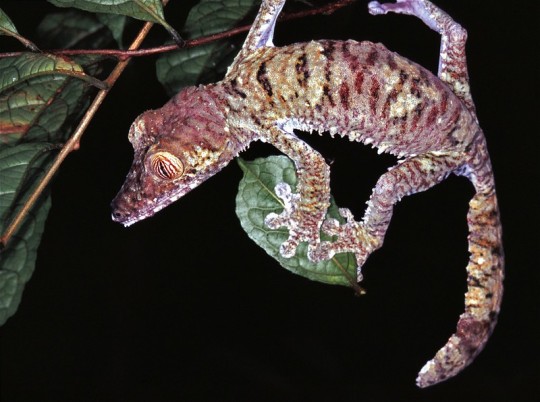
Common flat-tailed gecko (Uroplatus fimbriatus) in Nosy Mangabe, Madagascar, Africa
by Bernard Dupont
#common flat tailed gecko#geckos#lizards#reptiles#uroplatus fimbriatus#uroplatus#Gekkonidae#squamata#reptilia#chordata#wildlife: madagascar#wildlife: africa
87 notes
·
View notes
Text
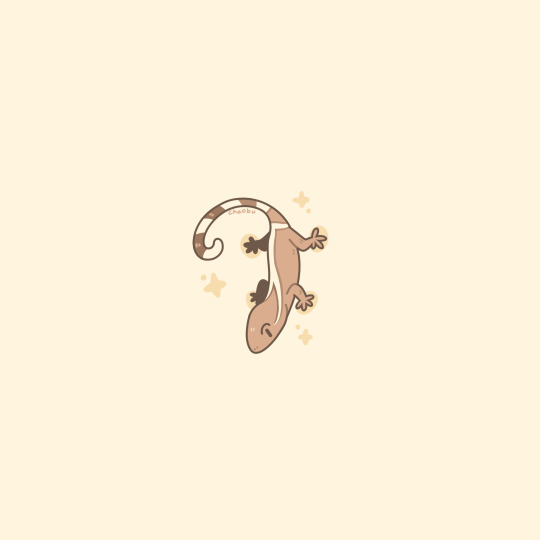





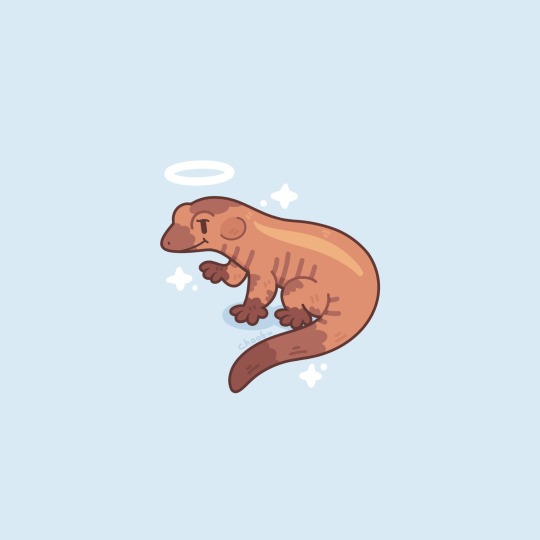

Tiny geckos [4/4] + Phylogenetic Tree
25 - Lined Gecko (Gekko vittatus)
26 - Northern spiny-tailed gecko (Strophurus ciliaris)
27 - Three-lined knob-tailed gecko (Nephrurus levis)
28 - Common flat-tail gecko (Uroplatus fimbriatus)
29 - Geckolepis megalepis, a species of fish-scale gecko
30 - Virgin Islands dwarf sphaero (Sphaerodactylus parthenopion)
31 - Delcourt's giant gecko (Hoplodactylus delcourti)
194 notes
·
View notes
Text
It’s been ages since I haven’t done this but lately I’ve been thinking abt gorons again yippie wahoo!!! 💥💥💥💥 I got some world build to share not only abt the gorons but for the rito and zora for my au! :] wish I could draw it but for now it is in written form
I wanna talk abt variants! Let’s start w the Gorons
Gorons have three types of “scale” variants the croco-goro, gecko-goro, and the sala-goro
Croco-goro have
Spiky scales; back shell looks heavy armored
Horns are typically longer
Tails are long could be excellent use for swimming
Daruk, Tarú, and Yunobo are croco-goros
Gecko-goro
Lot more rounder scales; back shell is more smoother but still armored
Tail is shorter and pudgier
Horns are smaller than a croco-goro’s
Their in-betweens of fingers and toes have webbing
Sala-goro
Very smooth/to no scales; back shell is very soft and is not armored aside from the spinal scales
Tail is long but is flat
Horns are small nubs
Some areas of their skin can be wrinkly
Now to the Zora :] Zoras have four categories Mammalian, Apex, Tropical, and Mantas
Mammalians are Zoras whose aspects follow similarly to a sea animal like a whale, dolphins, or orca
Apex are Zoras whose aspects are close to an apex fish predator like sharks, barracuda, salmon, or piranha
Tropical are Zoras whose aspects are close to a tropical fish
Mantas seems pretty self explanatory it Zoras that have manta traits
Finally the Rito 💥💥💥
Separating in three categories Tabantha, Hebra, and Faron
Tabantha Rito
There the Falcon and Owl rito in this region
Owl rito are less common than the Falcon rito
Hebra Rito
Hebra rito are Eagle rito
Their aspects look very similar to a Kargaroc (WW) and a Helmaroc
They are the tallest group of Rito
Faron Rito
The Parrot and Seagull rito
Feathers are either monochromatic or full with color (forgor the word for it </3)
Feet are webbed
86 notes
·
View notes
Note
I dream of having a big, smooth, HOT, flat rock on which to lay under a heating lamp or by a fire or something like a lizard. Would Kalymir like that too?
Also, does he like the beach? I could see him enjoying being salty and sandy and sunny.
[It would appear that I cannot differentiate between the literal icon of wrath and a gecko]
There are huge lizards in Wrath, actually. Since it's the physically hottest ring of them all, a lot of the species there are lizard-like. They're sort of a Wrath demon's version of a dog, Ludwig and his siblings had one as kids despite living in the Common Ring. Kalymir has had a couple of great lizards before (think of them as overly large komodo dragons essentially, sporting bright marks and sharpened backs/tails), and he's been looking for some new ones for a while actually. You can help pick.
While the Icon of Wrath doesn't necessarily lounge on rocks, he has a habit of sitting by his main fireplace- Not to mention the literal pool of lava he will physically dip himself into. This demon loves the heat, and it's no small wonder that you'd need to have a heat-resistance sigil branded on your skin to be able to withstand his palace for long periods of time...
Kalymir's time on the surface is usually spent causing mayhem, not exactly relaxing. He interferes in zones of high conflict and tension- Starting wars, other times disrupting them by sending legions to attack all sides. At best, he'll raid violent events like bullfights and the like, it reminds him of arenas, you know? The golden days!
That being said, you can pull him into a beach without that much bickering. He'll complain about it not being hot enough but otherwise probably enjoys the break. The beach will likely be emptied when you two show up, so you can bring a beach ball and fuck around. He's not much of a swimmer, but he likes seeing you wet. Just don't touch him with those cold ass hands.
71 notes
·
View notes
Text
(updated dec 3 2023)
Awani, also sometimes referred to as Hazedwellers, are a human variant that originated along the Serpent's Gulf in Auvedaya. There are no records of their civilization prior to the Great Impact. On first glance, they appear quite similar to the extinct original humans, though further examination reveals obvious discrepancies. Their irises take on distinctive colors, patterns, and shapes, and they have pointed ears of various formations. Some have a full set of pointed teeth, while some may only have a single set of fangs on the top or bottom. Like the original humans, their skin is typically shades of beige and brown. Their hair may be any color, though black is the most common. Their fingers and toes are clawed. They have frills in the same color as their scales and claws on their ears and the tips of their tails, as well as "whiskers" that let them sense changes in the atmosphere and help them navigate. When threatened, they can drop their tails - it will take from several months to a year to fully grow back. Their bodies are covered in scales which can range from thick and textured to so fine as to barely be visible or semitransparent and shiny. Regional variants of Awani are more suited to different climates.
Gunari, sometimes referred to as Cavedwellers, are a human variant that formed somewhere within the caverns of Florene, having already evolved into their modern species by the time of the Great Impact. Once residing deep underground, they can see in the dark and have antennae and/or whiskers to sense their surroundings. Due to the harsh environments they evolved in, they are more tolerant to low oxygen levels. In order to navigate the caves, they also have the ability to stick to walls, akin to a gecko. Their skin ranges from dull shades of red to blue, as they have deep indigo blood, and their hair and eyes can be any color. Their wrists, ankles, and the tips of their tails are wreathed in a tuft of fur. Typically, their large, floppy ears will be the same color as the base of their tail, while the tip has an appendage similar to their antennae. They have flat teeth. Like the Awani, they have regional variants depending on climate.
Individuals of either variant may be born as an Elemental, signaled by multiple extraneous body parts - most commonly eyes, mouths, or limbs. These people are able to channel magic to affect the physical realm to varying degrees, usually limited to a specific "element." Elementals are more prevalent among the Gunari, since some significant populations of Awani (i.e, Kalirangka and Ranlindyr) either did not ever have (in the case of the former) or almost completely lost (in the case of the latter) whatever gene controls the trait. Both species also have Oracles among their populations - a "condition of the soul" that allows for easier access to the astral realm. Though, they are notably more common in populations with low percentages of Elementals. Oracles have no physical magic powers, though they may experience prophetic visions, higher susceptibility to possession, and similar phenomenon. Unlike Elementals, Oracles are rarely evident at birth and more commonly created or awakened later in life. As both conditions rely on opposite states of the soul, it is not possible to be both an Elemental and an Oracle.
Awani make up about 60% of the general population, but account for about 75% of Oracles. Meanwhile, despite accounting for less than half the total population, Gunari are about 65% of the Elemental population.
Both the Hazedwellers and Cavedwellers are colloquially referred to as "human," typically when contrasted with spirits. Spirits may be humanoid in form, though they are completely separate from both the humans of Celantri and, uh, all biological creatures. Spirits originate from the astral realm and are composed of pure essence. Naturally occurring spirits tend to be more beastlike in behavior with highly abstract and flexible forms. In Old Kalirangka, a rare technique allowed powerful sorcerers to cultivate spirits with particular traits - most notably, sentience and high intelligence uncommon in natural spirits. This required a large amount of magic and excellent precision - even then, there was no guarantee that the artificial spirits, sometimes called simulacra, would continue to develop as planned once they gained consciousness. Unlike natural spirits, simulacra have more constructed appearances and stable forms, more likely humanoid in shape, depending on their intended function. Simulacra are exceptionally rare today, and much of the advanced knowledge from Old Kalirangka is lost. Modern attempts to recreate intelligent simulacra have repeatedly fallen short.
Becoming host to a relic will cause individuals of any species to grow horns. The amount and size of horns is typically proportional to the amount of magic they can channel, though the horns may be removed if desired.
3 notes
·
View notes
Photo
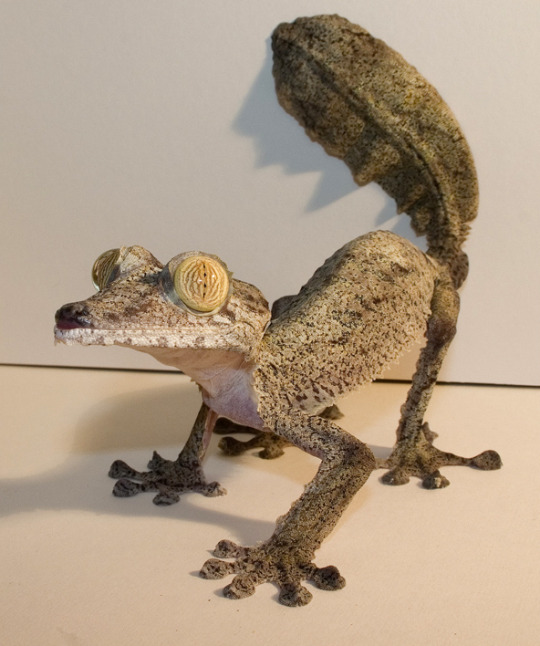
Uroplatus fimbriatus by AngiWallace
432 notes
·
View notes
Photo

Common flat-tailed gecko (Uroplatus fimbriatus) defensive posture in Madagascar
Frank Vassen
335 notes
·
View notes
Video
Common Flat-tail Gecko by Oleg Chernyshov
Via Flickr:
Common Flat-tail Gecko - Uroplatus fimbriatus - Мадагаскарский плоскохвостый геккон Gekkonidae. Peyrieras Reptile Reserve and Mandraka Reptile Farm, Marozevo, Madagascar, 11/19/2016
#Мадагаскарский плоскохвостый геккон#Common Flat-tail Gecko#Uroplatus fimbriatus#giant leaf-tailed gecko
0 notes
Note
I am by no means a bird expert, but if I were in that situation, the first thing I would do is research what species of birds are common in my area, and try to identify the species. Birds have specific diets and requirements, depending on the species. If it is possible, I would take it to the vet too, in case it is injured (it fell from a tree after all). Of course, I would provide water (everyone needs water). The bird here also seems to have developed some flight feathers already, it is an older more developed bird, I guess that would make identification easier (and you won't have to take care of it for long). I would ask on a Reddit forum or a discord server, while people there are not always reliable (I once had someone misidentify a flat tail gecko as a gargoyle gecko, which was bonkers, even I could tell those species apart) they can give you an idea on where to start your research. The bird subreddit has very kind people in it for what I've seen.
You probably already knew this and you are probably already doing your own research by now but I thought maybe I could help a little? I dont know. I hope the bird does well!
Yeah, all the stuff I saw online was like "don't feed it, keep it overnight in a dark place and if it survives, take it to a wildlife rescue center!" but uhhhhh I'm not sure if I would be able to get them to a wildlife rescue center tomorrow, what with it being Easter and all. I'm not sure if they're even open. The nest one of them came from that I COULD get to was in someone's hanging potted plant right near their door, so I sincerely doubt that mama has a major problem with humans being near her nest or that she'll be spooked by my presence at all, so I can probably keep checking on them. I did put it back in the nest because. Well. Bird probably knows how to take care of bird better than I do, but if it seems like the mom pushed them back out, I'll take it to a wildlife center for sure. Imma look in again tomorrow (when I went to put them back, another one had fallen out, this time into water, so I scooped him out too and covered up the water so they won't drown on accident, but obviously they're having problems falling out of the nest a lot), and I'll probably do a reverse google image search for sure (my best bet is they were mocking birds, because those are pretty common around here). They were moving a lot, stretching their wings and face and legs and pooping on my hands when I picked them up, cheeping, opening their mouths for food, and they didn't seem dazed at all, just scared, so I don't think they're badly injured, and I really want to minimize my interactions with them. The one hopped into the nest okay, so I think he's chill with his new siblings, and they don't seem to mind him. Bird found family, I guess. Thanks for the Reddit tip, I didn't think to look around there.
8 notes
·
View notes
Text
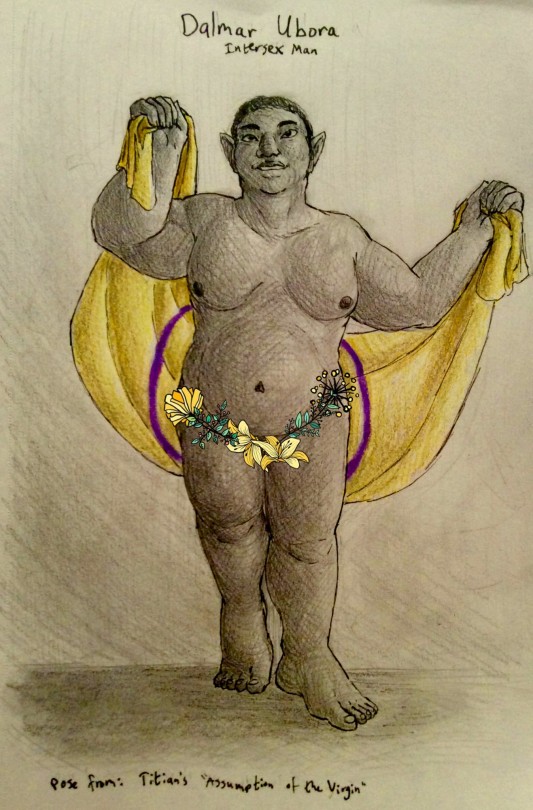




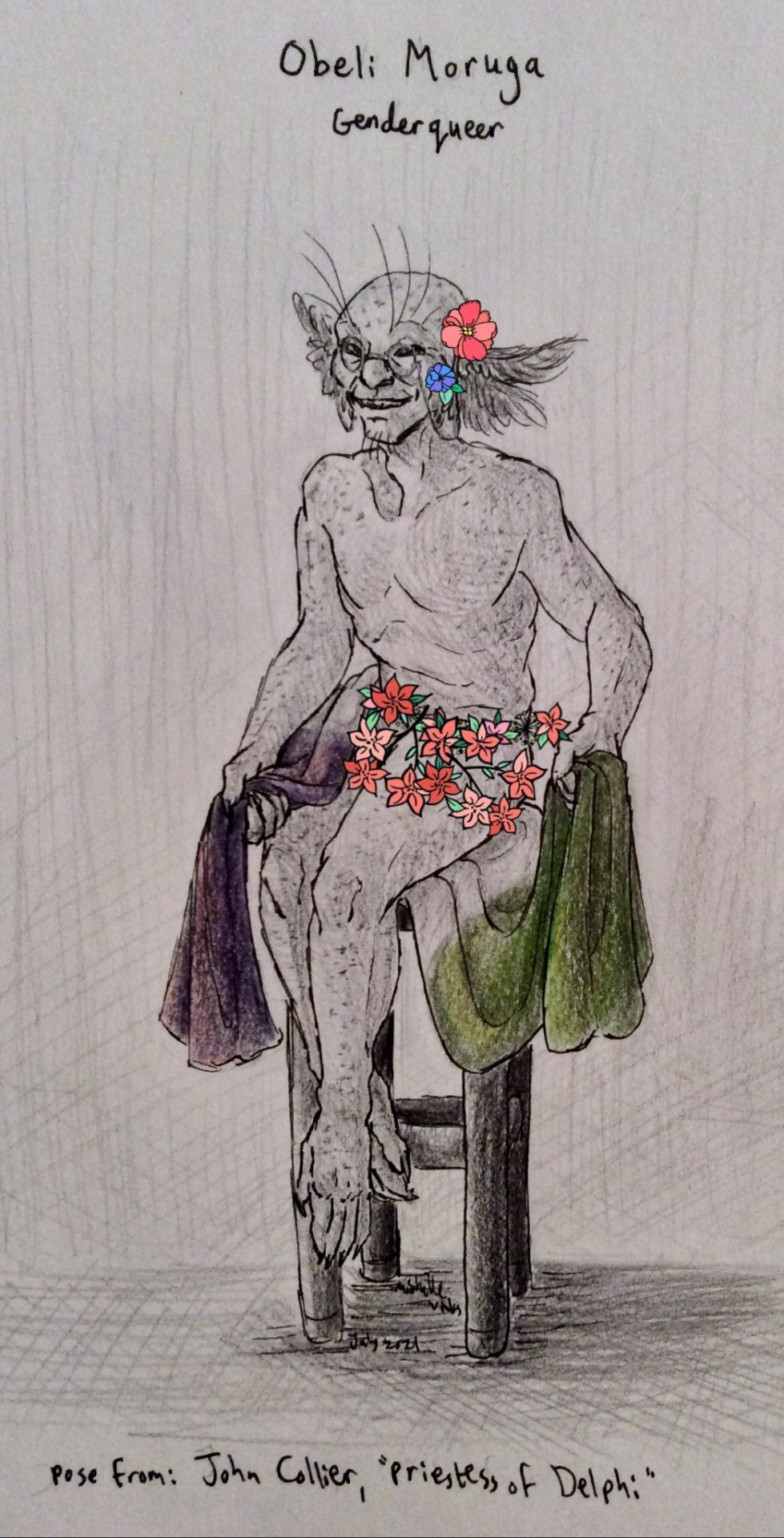
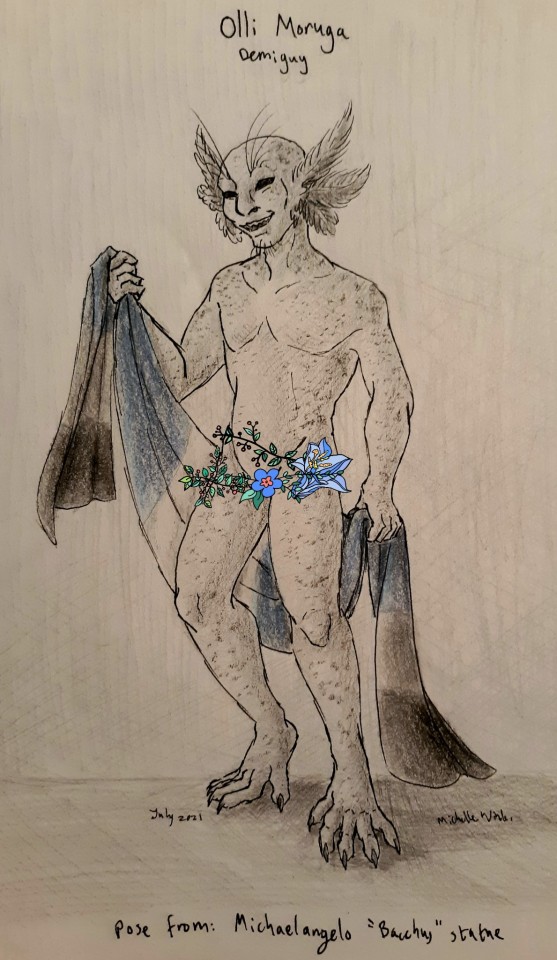
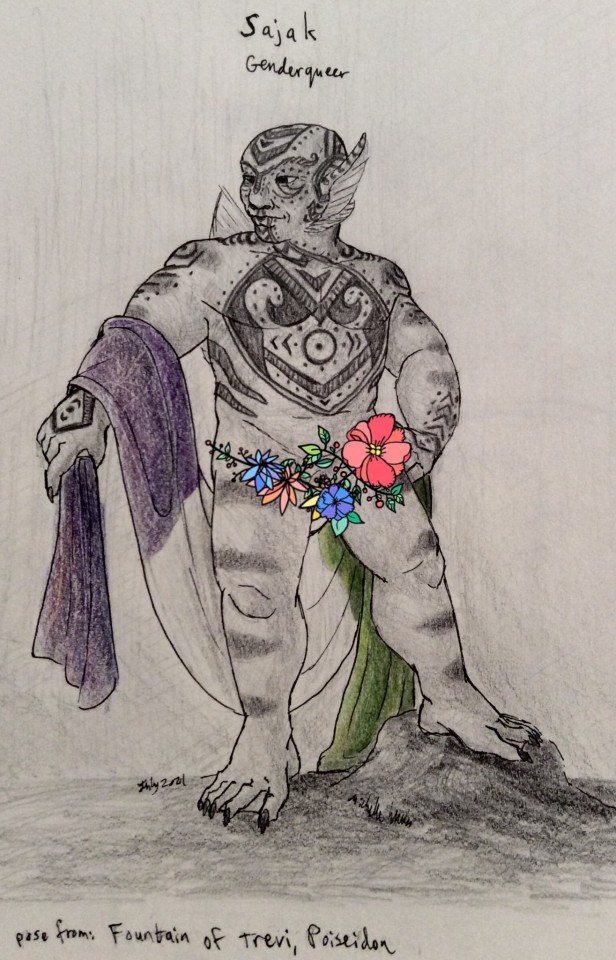
(image description: eight sketchbook drawings of characters holding a variety of pride flags, all nude and posed in ways that match some old fine art pieces. The nudity has been censored with cute digital flower stickers. end description.)
Characters:
Dalmar, intersex man. Kouto, nonbinary. Chacha, agender. Parva, nonbinary. Xulic and Kidron, genderqueer. Obeli (or Abuela) Moruga, genderqeer. Olli, demiguy. Sajak, genderqueer.
Genderqueer is kind of my default for "well, biologically and culturally, they already don't have binary sex or gender, so they kinda default to genderqueer." And I know maybe some people will be bothered by that, but it's just part of the worldbuilding I've written around all these non-human and frequently non-mammalian species of people.
The uncensored version is on my Patreon page. I do have one more drawing to add to this series, but since it's four child characters I will not need to worry about adding any censors and keeping the original image only on my patreon, as they will simply be wearing their pride flags as whole outfits.
The previous part of this, my binary trans characters, can be found over here.
detailed character descriptions and explanations of the pose references under the cut
Dalmar Ubora, a black intersex elf man with short black hair. He is holding his arms up as he holds the intersex flag, mimicking the pose of Virgin Mary from Titian's painting "The Assumption of the Virgin". The shading was washed out by the photo, but his belly is still clearly round from pregnancy. Dalmar is an interesting case, in that he was assigned male at birth based on his outward appearance, continues to identify as male throughout his life, but finds during puberty that what was believed to be an undeveloped penis was actually just a non functional body part. Instead, what actually developed to full functionality was his uterus. He still identifies as a straight cis man, and has come to terms with his body. He is married to a medically transitioned trans woman, and he could undergo operations to change his body if he wanted to. Instead, he has embraced his body and even birthed some children who were conceived via sperm donations. This is why I wanted a Mary pose for him, and this painting in particular is about Mary being welcomed into heaven as a blessed holy woman. Dalmar may not be a miraculous holy figure, but there is a reverence in the way he has come to love his body and chosen to bear children, including the surrogate birth of his brother's child.
Kouto Hayashi-Loryck, a slender nonbinary elf with black hair tied into a bun. They are holding the nonbinary flag and standing in the pose of a statue known as "Apollo Belvedere", which is so old no one knows the artist's name. One arm raised, one lowered, legs in the relaxed contrapposto pose. Kouto is an artist and an art model. Apollo is a god of the arts, and regarded as a beautiful and sexual figure. Kouto is bisexual and admittedly a very sexual and flirtatious person. They did settle into a happy marriage though (actually they are Dalmar's in-law and the sperm donor for the aforementioned surrogate birth.) Marriage has not stopped Kouto's flirtations, merely limited their targets to a singular person. It felt right to give him this pose, from a pretty well known portrayal of Apollo. Beauty, art, and sex, all defining traits of Apollo and Kouto alike, all present in a pose where the figure seems to be reaching for something above them.
Chacha Faraji, an agender black elf with short hair. They are facing away from the viewer, seated on a stool that is covered by the draped agender flag. No physical traits that could betray their agab are visible. Chacha is sitting in the pose of Reubens' painting "Venus at the Mirror". The arm closest to the viewer ends at the elbow, while they hold a mirror in front of their face with their one whole arm. Their face is seen reflected, smiling, little wrinkles visible by their eyes. I chose this painting in part because it did allow me to obscure Chacha's agab. They were my first nonbinary character, and I never really settled on an agab. But also, I enjoy putting characters who have unconventional bodies into poses associated with Venus or Aphrodite, the goddess of beauty. Chacha is missing half an arm, they are getting older and it shows in the wrinkles on their face. Chacha is also Aromantic and Asexual, the full queer triple A battery. The mirror pose has become an independence of beauty. "Look but don't touch." Chacha is beautiful, and they do not need to be beautiful for anyone but themself.
Parva Turbatus, a white nonbinary elf with shoulder length curly hair that has been shaved down on the far side of their head. They are holding the nonbinary flag, standing in the slightly closed off pose found in Paul Gariot's painting "Pandora's Box". One hand on their chest, one hand held out to hold the flag. They have top surgery scars on their chest and a c-section scar on their navel, though all of these have unfortunately been hidden by the flower censors. I chose a pandora pose for Parva because they have one of the most intense tragic backstories of any of my characters. Like Pandora opening the box, they have suffered through many things but came out the other side with Hope, and healing.
Xulic Vos and Kidron Engedi, a drow and a lizard person. They are sharing the genderqueer flag. Xulic has long ears and white hair in a braid, with a white monkey-like tail barely visible behind their legs. Kidron looks like a leopard gecko, and their tail is acting as a visual block in fron of Xulic's groin. They are standing together in the central pose of Raphael's "School of Athens" fresco. Xulic is pointing one hand up to the sky, while Kidron holds one hand palm down towards the earth. Xulic's chest is visibly flat, however I have rewritten the drow as a eusocial people, who's biology has made most of the common population infertile and visibly near identical above the waist. Xulic's agab is unknown to anyone but them, and perhaps their reptilian lover Kidron. Both drow and lizard folk have biology and cultures that do not really support a gender binary, so genderqueer suits them both quite well. I chose the School of Athens pose because these characters are scientists in fields that overlap, and they often get into deep discussions on the matter. Xulic is a paleontologist while Kidron is a geologist, and they have another friend (my protagonist) who studies archaeology.
Obeli (or Abuela) Moruga, an elderly goblin with sagging skin and axolotl-like frills on the sides of her head. She grins as she holds the gender queer flag, partly draped over the tall stool she is seated on. Her pose matches that of John Collier's "Priestess of Delphi" painting, which depicts a woman hunched over herself on a stool. Old Obeli Moruga, whose title best translates to "grandmother" is a significant figure in her community, both because of her more practical role as a leader and wise woman, but also because she has gained immortality and become an incarnation of Life Itself, after she was given the offer of such power when she nearly died in the goblin revolution. There are many figures that would suit her. Poses from statues of goddesses, like Athena or Gaia. Perhaps turning away from the theme of greek and roman figures I ended up with for my nonbinary group (dalmar is his own thing) and using the famous painting of Liberty on a battlefield. But now in her old age, all those poses of figures in more active poses, tall and imposing, simply didn't feel right. A wise old woman, hunched on a stool in a pose associated with the idea of an oracle, a priestess, a prophetess, felt much more fitting. (goblin culture does have specific pronouns for leadership, and in the common speech they have decided this translates best to the feminine "she/her")
Olli Moruga, also a goblin with axolotl-like frills, standing with the demiguy flag in his hands. He is in the pose of Michaelangelo's statue of Bacchus, god of wine, merriment, and madness. One hand up as if to salute with a cup, body leaning and perhaps a little unstable. Olli is a gay demiguy, stepping away from the naturally ungendered state of his people to embrace masculinity instead. He is extroverted, loves a good party, and has definitely been a little over his depth with alcohol on many occasions. He knows this is a problem. He used to act rebellious because of it, trying to be cool and aloof, but he has since admitted the truth to himself and now openly seeks help. His trans lover, Zaire (seen in a previous post) has become a great support to him. Even though it may seem odd to use the pose of a god of wine for a character that is trying to overcome an alcohol issue, I still feel like the vibe of Bacchus or Dionysus fits Olli well. He is not only a god of wine, but also of pleasure in general, a concept Olli embraces. Wild joy, perhaps to the point of becoming a little feral, abandoning tradition for personal fulfillment. It is unusual for goblins to embrace a binary gender, even partially. Gendered pronouns do not exist in their tongue, only being used in cases where common speech needs to be used to refer to certain significant figures, such as a leader. It is also unusual for a goblin to take a lover outside their species, since most goblins live in fairly isolated places and all mate together seasonally, depositing their eggs in a communal nursery pool. Olli stands out on purpose.
Lastly, Sajak, an amphibious person with some fish-like features such as their finned ears and a barely visible dorsal fin. They are holding the genderqueer flag as they stand in a commanding pose, one foot on a rock, one arm held out as if pointing to something below them. This pose is taken from the central Poseidon statue in the fountain of Trevi. Their head, arms, and torso are covered in dark tattoos in abstract designs, and they also have a few natural dark stripes along their arms and legs. The obvious connection between Sajak and this statue of Poseidon is that Sajak is a fish person and Poseidon is an ocean god. If I could have thought of a more medical figure, I may have made a different choice in the art reference. Sajak is primarily a doctor, a healer. They are fairly well known and they were an important figure on their home island, though they did leave eventually. Even so, there is a certain vibe to Sajak that suits the image of a powerful and unpredictable oceanic god. They are steady, intelligent, and careful, but they can become fierce when their loved ones are under threat, and the intense focus they show in their work as a doctor can be intimidating to see. There is a feeling of hidden power within Sajak, just as there is in the ocean when it seems calm. Fish folk, whether bipedal and amphibious or fully aquatic, also fit under my category of "non-mammalian people who are just kind of genderqueer by default due to their biology not fitting into a binary".
#figure art#figure drawing#nonbinary#intersex#genderqueer#queer ocs#winks ocs#image description#accessible art#my designs#drow#lizard folk#elves#goblins#merfolk
40 notes
·
View notes
Text

Grzimek's Animal Life Encyclopedia. Volume 6: Reptiles. Written by Bernard Grzimek. 1984.
1.) Tokay gecko (Gekko gecko)
2.) Peacock day gecko (Phelsuma quadriocellata)
3.) Auckland green gecko (Naultinus elegans)
4.) Kuhl's flying gecko (Ptychozoon kuhli)
5.) Mediterranean house gecko (Hemidactylus turcicus)
6.) Common wall gecko (Tarentola mauritanica)
7.) Day gecko (Phelsuma madagascariensis)
8.) Common flat-tail gecko (Uroplatus fimbriatus)
#reptiles#lizards#geckos#tokay gecko#peacock day gecko#auckland green gecko#kuhl's flying gecko#mediterranean house gecko#common wall gecko#day geckos#common flat-tail gecko#signature
172 notes
·
View notes
Photo

Variations in the common flat-tailed gecko (Uroplatus fimbriatus), a native reptile of Madagascar.
SciArt from Reptiles, Amphibia, Fishes and Lower Chordata (1912). View more in @biodivlibrary with thanks to @smithsonianlibraries for digitizing.
187 notes
·
View notes
Photo

Close up of a common flat-tail gecko’s (Uroplatus fimbriatus) eye
204 notes
·
View notes
Text
These Incredible Geckos Crash-Land on Rainforest Trees but Don’t Fall, Thanks to Their Tails
These Incredible Geckos Crash-Land on Rainforest Trees but Don’t Fall, Thanks to Their Tails
An Asian flat-tailed house gecko, Hemidactylus platyurus. Videos of these geckos, common in the forests of Singapore, showed that their tails allow them to recover effectively from crash landings on tree trunks. Credit: Ardian Jusufi
Scientists find another use for lizards’ versatile tails: stabilization after headfirst crashes.
A gecko’s tail is a wondrous and versatile thing.
Gecko after…

View On WordPress
0 notes
Text
Juniper publishers- A Survey of the Abundance, Population Structure, and Distribution of Mugger Crocodiles (Crocodylus palustris) using day Ground Surveys in District Bhopal and its impact on Community

Abstract
Mugger crocodile (Crocodylus palustris) are one of the planets oldest living creatures, thought to be around 200 million years old which means that crocodiles were around in dinosaur times. The Indian Maggar crocodile is a critically endangered species of freshwater Crocodilians were once abundant in many tropical waters around the world. The dangerous levels of exploitation came with the rise in demand for crocodile leather throughout the world especially in the European countries. Crocodiles were killed illegally every year to make wallets, shoes, handbags, and belts. With rising demand, hunters turned to more lethal methods. Using high-powered rifles, spotlights, and power boats, hide-hunters have pushed many species to the edge of extinction.
Mugger is common in many parts of India and is reported over 12 states. Presently the mugger population is estimated over 4,500+ in the wild, excluding 5000+ in captivity [1]. In the Pre-historic period only seven species resided in India, and the number has decreased to Due to hunting and habitat destruction, the Maggar population was reduced significantly. Now only three primary species: Mugger crocodile (Crocodylus palustris), estuarine (coast) crocodile (Crocodylus porous) and Gharial (Gavialis gangeticus)
The reptile fauna of India consists of about 460 species; with 244 snakes, 178 lizards, three crocodiles, and 35 turtles. In the previously research study regarding Madhya Pradesh Publish in zoo print journal there are 01 crocodile, 01 Ghariyal, 11 turtle & tortoise, 32 lizard/Gecko/Agama/Skink 19 frog and 38 species, of snake [2]. In Madhya Pradesh first time preliminary assessment (survey)to know the population and habitat distribution of Maggar Crocodile was conducted in the aquatic bodies of the Bhopal city. Result of this study repotted 1 Ghariyal & 12 Crocodile species The population of crocodile Estimated by interview method & Direct Day count, method in winter of 2017- 2018.
The area under Biotic pressure due to urbanization, tourism development project and local community. All aquatic bodies are traditionally used by local people for fishing, bathing, washing of cloths. activities resulted in shrinkage, degradation and destruction of natural habitat. Conclusion of study is given develop a method to estimated population, recognized the habitat for conserve the mugger Crocodile species in future and helpful to draw effective management plan.
Aims & Objective: The main objective of the proposed study is to conduct an assessment and determine the status/distribution of mugger crocodile (Crocodylus palustris) inhabiting the Bhopal region, investigate human-mugger crocodile interaction situation, promote activities for crocodile conservation and ultimately propose actions that should be taken to conserve the species in this region.
a) To update the status of Mugger Crocodile through surveys, Study of habitat features and population structure behavioral biology including reproduction, thermo-regulation, feeding, water-orientation, locomotion etc.
b) To protect and conserve the remaining population of crocodilians in their natural habitat and identify habitat that would be suitable for restoration.
c) To identify the causes of declining Species status, To take-up research and
d) use Finding for future Best and effective management.
e) To build up Awareness among local people for conservation of Maggar Crocodile.
Status/Threats: The Muggar Crocodile is classified as Vulnerable (VU AI aC2a) on IUCN Red Data list 2004 and is listed on Appendix I of Cites. The mugger crocodile greatly decreased in number until the early 1970s. Killing of the species for skins was the primary cause of their decline in India [3]. It was most vulnerable to this during years of drought when hunters could track and kill the animals more easily. Habitat destruction and alteration was another primary cause of species loss. Many dam construction projects that occurred during the 1900s to the 1950s destroyed habitat by removing areas of deep water that provided good cover. Timber operations also destroyed habitat during this same time, by damaging forest ponds and rivers. Egg collection, hunting of crocodiles for meat and medicine, and death from fishing nets also have contributed to their decline [4] (Britton A, 1995). Throughout the 1960s, surveys indicated that numbers of the mugger crocodile were on a swift decline. However, conservation and restoration did not begin in earnest until 1972, when three crocodile species, including the mugger, the saltwater crocodile, (Crocdylus porosus) and the Gharial, (Gavialis gangeticus) were placed in IUCN’s Red Data Book. Also, during this year, the mugger crocodile was included in the schedule for the Indian Wildlife Protection Act of 1972, [5]. This act provided for greater protection of habitat.
Keywords: Reptile; Diversity; Habitat; Endangered Species; Conservation; Protected Area; Population; Monitoring; Faunal diversity
Go to
Protection Status
The International union for conservation of Nature & Natural recourses (IUCN) Placed the Maggar Crocodile (Crocodylis palustris) as vulnerable under in Red data Book of endangered species in 1972 in Schedule - I given high degree protection.
Go to
Mugger Crocodiles (Crocodylus palustris)
Muggar are in some report Largest modern reptile back bone (vertebrate) cold blooded (depends on outside source for its body temp) lay shelled egg breath air (well develop long) four chamber hearts teeth filmy set in long flat jaws with their extraordinary range of body size. Due to Four chambered heart & well develop lungs they can also stay underwater for extended time because they can slow their heart rate; allowing them to hold their breath for longer. Crocodiles can see underwater due to a transparent lid that closes over their eye to protect it. They also have excellent night vision; due to a specialized retina; as well as a good sense of smell. Small sensory buds around the top and bottom jaws allow crocodiles to detect vibrations-crucial when hunting in murky water.
Crocodiles are large and skillful predators that hunt by stealth. Their muscular tail propels them through water and allows them to lunge forward with great power and speed. It can also be used to thrust them vertically to capture a bat or bird in mid-flight or in foliage. However; they cannot maintain strenuous activity for long periods and can easily become exhausted while capturing prey or fighting other crocodiles. Extreme exertion is done an aerobically (without oxygen) and must be followed by a period of rest so that the ‘oxygen debt’ can be repaid to their muscles. The result of anaerobic activity is a build-up of lactic acid in the blood. Although crocodiles can withstand higher levels of blood acidity than other animals; sometimes it can be fatal.
Mugger Crocodiles (Crocodylus palustris) scenario in India
Madhya Pradesh the land of diversity is one of the most exiting wild life destinations of India. The protected area (included National Park; Project Tiger and Sanctuary) in Madhya Pradesh is 14324.844 (in Sq. Kms). The reptile fauna of India consists of about 460 species with 244 species of snakes; 178 lizards; three crocodiles; and 35 turtles.
The mugger crocodile is a freshwater (Vulnerable) species found sparsely in various lakes; rivers and marshes in the Indian subcontinent. They have also been found in reservoir irrigation cannels and other human made fresh water bodies [6]. Presence of crocodile is recorded in most parts of the India Mugger crocodile. The notable mugger population is recorded in Tamil Nadu; Kerala; Maharashtra; Goa; Uttaranchal; Uttar Pradesh; Orissa; Gujarat and Rajasthan. but presently in 12 states of India; the total population of crocodile population is estimated at 4000+ in Natural habitat as per inventory of Central Zoo Authority for the year 2016-17 in 23 states the captive population of 185 Males; 186 female and 2121 unknown i.e. total 2492 in captivity. [7] Central zoo authority of India; inventory; 2017-2018. The average mortality is 23.333 % and birth rate is 43.598 birthrate and mortality are show the draw the effective management to multiply pollution program.
Mugger Crocodiles (Crocodylus palustris) scenario in Madhya Pradesh
Three Crocodilians Species is a home many parts of India Mugger crocodile (Crocodylus palustris); Salt water crocodile (Crocodylus palustris) & Gharial (Ganvialis gangeticus) in which 1 species of Maggar crocodile (Crocodylus Polustris) and Ghariyal (Ganvialis gangeticus) are found in Madhya Pradesh. The Crocodile population in protected areas Management plan in Madhya Pradesh are very less in number Population & status data is not available in others working plan aquatic bodies eg. lake river pond lakes; dam nala; Nala stops dam of nearest local residents have direct and indirect evidence regarding presence of mugger different part of state in revenue area however; at present there is no effective management plan prepare for conservation of Mugger.
Apart from this there is 3 medium zoos in Madhya Pradesh. As per the central zoo authority inventory of zoo animals’ analysis the data from 2011-2015 which reported there is 3 male; 4 female and 36 unknown gender crocodile in captivity (Table 1). The birth rate is 0.692% and the mortality is 3.889% due to which the mortality is greater than the birth rate shows that the management is not proper.
Ghariyal population scenario in Madhya Pradesh
Gharial (Gavialis gangeticus) the only survivor of the Gavialidae family is one of the most endangered crocodile in the world. The Madhya Pradesh Government has declared three sanctuaries for the conservation of crocodiles. They are:
a) National Chambal Sanctuary
b) Son Gharial Sanctuary
c) Ken Gharial Sanctuary
In National Chambal Sanctuary sanctuaries habitat area (length x river width) is 128 Sq. kms with small patches of Ghriyal Habitat and as per survey of 2007 the total population is 208 adults. Son Gharial Sanctuary is 13.5 sq.km and the population is (survey 2006) more than 38 adults. With the best management practice the population of gharial will be increase.
In Van Vihar National Park/Zoo since from the year 1995- 96 to 2017-18. According to table; the Captive population of the crocodiles (Mugger) in the Van Vehar National Park Zoo is declining. It is found that efforts have been taken up by bringing male dominant species for increasing the population in year 2012-13. This effort made by the Forest Officials is appreciated and fruitful but the causes behind the declination may be the proper site suitability; lack of management or environment for habitation of crocodiles in the zoo. It is also observed that the ratio of the male dominant is very less to negligible compare to female crocodiles. The present scenario states that only 10 male crocodiles were brought compare to female numbers 149 in total of past 23 years where the ratio is almost 1:15. To increase the population of crocodiles and conserve the life of the endangered species; it is suggested that the ratio of the dominant male compare to female must be 2:5 for the production in numbers. Training programs must be provided by introducing crocodile experts and proper management has to be taken up by the National Park Zoo Authorities.
Go to
Material Method Study Area
The study area selected was aquatic bodies located in Bhopal city the state capital of Madhya Pradesh lay down between Latitude : 23° 15’ 35.7588’’ N & Longitude : 77° 24’ 45.4068’’ E; the total area of Bhopal is 285.9 km2 & the population is 1;798218.8 (As per India census 2011) The terrain of Bhopal is undulating and sildly hilly. The city was the capital of the former Bhopal State. Bhopal is known as the City of Lakes for its various natural as well as artificial lakes and is also one of the greenest cities in India. The Upper lake is a large lake which lies on the western side of the city have been built by the Paramara Raja Bhoj during his tenure as a king of Malwa (1005-1055). It is a major source of drinking water for the residents of the city; serving around 40% of the residents with nearly 30 million imperial gallons (140;000 m3) of water per day and Lower Lake is located to the east of the Upper Lake. An earthen dam separates the two lakes. 10 other aquatic bodies (Total areas is 43468863.95 selected for the Assessment of crocodile population status & distribution.
Equipment
a. GPS (Garmin)
b. Map of study area 1:50;000 with 30 second interval
c. DCLR Camera (Nikon D-90)
d. Binocular (7×10)
e. Survey sheet (Questionnaire)
f. Scale; Pen; Pencil with Nate book
g. Vernier caliper (for dunk measurement)
h. First aid kit
Based on Daily Newspaper and Media news Repotting crocodile rescue from aquatic body of Bhopal in first survey was carried out from 10 January to 13 January 2016 in result only 7 crocodile and 1 ghariyal is spotted. In year 2017 -2018 final survey was carried out from 2 December to 31 December 2017in the potential area by boat during the day time (10.AM to 1 .00 PM). for estimating Population of crocodile & their distribution by direct count method (Sun Basking Count Method) (Figure 1).
Go to
Primary Data Collection
Questionnaire survey
The primary data collected is based on the information collected though different sources like preparing questionnaire; interviewed of people & group discussion. The questionnaire included question on topography of Area; presence of crocodile and their habitat (Direct and Indirect sighting); Evidence of presence; habitat (Nesting & barrow); Men & Crocodile conflicts; local people knowledge of mugger crocodile; local people dependency on water bodies; in study area population of Mugger Crocodile increase/ decrease in past year; poaching and trading activities etc. (Figure 2).
Interviews and previous data can be helpful for the initial visit to a site as a method to obtain background information or in determining current research needs [8] (Thorbjarnarson 1988; Thorbjarnarson and Hernandez 1988). Questionnaire survey with 237 local resident people. Fishermen; public & tourist in the month of September & October 2017 in which only (28 questionnaire reports 14% of people interviewed have seen crocodile.
Day light ground method; direct sighting
Day time Ground Count is nice method in which least equipment required day time can be done by foot or boat as per size of water body area some time reducing transport & logistic Cost Magansson 1982 [9]. Crocodiles use the water; sun and shade to maintain their preferred body temperature of 30-33°C. When basking; they orientate their bodies to ensure the maximum surface area is exposed to the sun. Crocodiles cannot sweat. To avoid over-heating; they may return to the water or lie with their jaws a gape; allowing cool air to circulate over the skin in their mouths. This process of heating and cooling their bodies is called thermoregulation and is crucial for many bodily functions including digestion and movement. Often observed basking on the banks of watercourses where they are generally inactive; crocodiles are less likely to be seen when they are in the water. Livelier in the water; crocodiles can swim just below the surface; with only their eyes and nostrils visible (Figure 3).
As per collect survey local resident people in the Questionnaire where crocodile was observed in previously & potential areas selected three water bodies out of ten; (1. Upper Lake 2. Kaliyasot Dam; and 3 Bhdbhada Dam + Smiriti Van Bhadbhada). For counting crocodile; a team of 2-4 local people depending on the size of Aquatic body to be surveyed in the day time 10-AM to 1.00 Noon. Day light count Required the least equipment and area the most easily arrange however many zero count have been associated with day light ground given the crocodile refrain from basking with cloudy weather or when the optimal body temperature is reached [10].
Go to
Result
Day time survey
The Population & their distribution of crocodile are estimated by direct count method (Sun Basking Count Method) survey was carried out from 10 January to 13 January 2016 in the potential area by boat during the day time (10.AM to 1 .00 PM) [11]. The survey revealed a total of only destroys nests of the Crocodile and 07 species found in direct sighting. The Total Count report is given in given below (Table 2).
Distribution of Crocodile Observed (Day light Ground method).
Go to
Discussion
Interview survey
Interview with the residents were conducted to understand attitudes towards muggers and to assess the human-mugger interactions. Interviews and previous data can be helpful upon the initial visit to a site as a method to obtain background information or in determining current research needs10 (Thorbjarnarson 1988; Thorbjarnarson and Hernandez 1988). Figure 4 Questionnaire survey with 237 local resident fishermen; public & tourist in the month of September & October 2017 in which only (28 questionnaire reports 14% of people interview have seen crocodile [12-15] (Table 3).
Distribution of Crocodile Observed (Day light Ground method).
(02 December to 07 December 2017) First Round.
Indirect sighting/evidence of presence:
Crocodile tracks dung; trails; dens; footprints and nest are not found in study area.
Night time survey
Night spot light survey is preferred method of crocodile survey (Magnusson 1982) because of their versatility in habitat and nocturnal nature of the animal. But in night time Survey required special skill and manpower so night survey is not done [16-19].
Mortality
Natural mortality and accidental death of crocodile is not reported in study area.
Human and Crocodile conflict
The incidence of crocodile attack on human is none in study area because the population of crocodile is less in compare to large aquatic body; so, food available and habitat area is enough; so, the territorial difference not seen in wide range of prey so with increasing body size Figure 4a. Crocodile not took a big size prey from body size. Causes for attacking behavior of crocodile are in defense for their nest and siblings; mistakenly identifying animal accompanying with people or Human are considered to have been case of mistaken identifying type of incidence or attack are not recorded in this area [20-23].
Water quality
Water quality of aquatic bodies gets contaminated every year by accumulation of sediments; human waste; and House hold waste organic material (Table 4).
Population & habitat Assessment Survey
Wildlife habitat for Crocodile in year 2017-18 estimate Crocodile wild population is 21. As well as other wildlife (Birds & Reptile) are very good. Encroachments in the habitat or in its fringes is continues process; None Crocodile and men conflicts found in Study area no none people repotted from crocodile attached by minor Injuries or death cattle of human and Domestic animal. Natural mortality of crocodile is not repotted in study area. All identified site location faces due to direct and indirect activity Water sports and similar activities can all have negative impacts on habitat of crocodile (Table 5).
Security
4 No Forest staff engaged or depute to report their status and Protection.
Festival
People generally ignore environmental impact of pollution on Air; Water; Noise; solid Waste; etc Figure 4b. While celebrating Ganesh; Durga Pooja and Muharram; with a Tazia festival water pollution caused by Visarjan i.e. The immersion of lord Ganesh and goddess Durga; Tazia Pop; Cloths; Bamboo stick; wood part paper thermocol jute & poisonous colours Synthetic Non-dissolving paints; Iron.4 in lakes; rivers and Sea which are made from Plaster of Paris (PoP) i.e. calcium sulphate hemi-hydrate. It takes several months to totally dissolve Ganesh Idols made up of PoP into water [24-26].
Ecotourism
The boat club or Zoo road side without consideration use for tourism one Cruse boat and other motor boats activities are responsible for cause of disturbance of habitat of reptiles and their movements. It is an ideal place to enjoy water sport activities like kayaking; canoeing; parasailing; and water-skiing Figure 4c. In winters many migratory birds come from distance of 1000 km of mile but due to human activity; noise & Disturbance causes decreasing of population of migratory birds’ day by day (Table 6-7).
Waste
House hold waste & Impurities are drawn in coming from colony Hotel farm house and Resort.
To read more articles in JOJ wildlife and biodiversity
please click on: https:// juniperpublishers.com/jojwb/index.php
For more open access journals in juniper publishers
0 notes